Quality of the Environment in Japan 1996
Part II
Policies Devised Concerning the State of the Environment and Environmental Conservation
Introduction
The Basic Environment Plan was decided upon by the Cabinet in December 1994. This Plan sets the long-term objectives of environ-mental policies foreseeing through the middle of the 21st century, and systematically clarifies the measures that can be expected in national policies, local governments, businesses and citizens by the beginning of the 21st century, and stipulates the role of each sector and the neces-sary measures in order to effectively promote the environmental poli-cies.
As the overall objectives of this Plan, "the realization of a socio-economic system based on a cycle that imposes a small burden on the environment" (Environmentally Sound. Material Cycle), "the coexistence of nature and man"(Harmonious Coexistence), "the realization of the participation of all sectors of society under a fair allotment of roles"(Par-ticipation) and "the promotion of international activities" (International Activities) are mentioned as the long-term objectives of environmental policy towards an environmentally sustainable society.
FY 1995 was, essentially, the first year following the decision on the Basic Environment Plan. Beginning with this year's report, the poli-cies of the government are being reorganized in line with the composi-tion of the Basic Environment Plan, so that the policies can be under-stood along with each item of the Basic Environment Plan.
Chapter 5. The Realization of a Socioeconomic System Based on a Cycle that Imposes a Small Burden on the Environment
In the Basic Environment Plan,with respect to the Environmen-tally Sound Material Cycle,the following is mentioned as a long-term ob-jective.Burdens on the atmosphere,water and soil are caused by in-terference with nature's circulation of materials. To reduce these bur-dens,our socioeconomic system must be based upon nature's circula-tion of materials. Thus,things removed from the Earth,such as raw ma-terials and energy,must pass cleanly through our socioeconomic sys-tem at every stage,from production,through the stream of commerce, to consumption and finally to disposal. Plans to limit the occurrence of waste and to properly dispose of it are essential. This Plan aims to cre-ate such a system.
As policies for the purpose of achieving this Environmentally Sound Material Cycle,the protection of the atmosphere,the protection of the water environment,the protection of the soil and land,waste re-duction and recycling,measures on environmental risk of chemical sub-stances,environmental consideration in technological development and responses to new problems are stipulated.
Section 1. Conservation of the Atmospheric Environment
1. Conservation of the Atmospheric Environment on a Global Scale
(1) Global Warming Countermeasures
A. Summary of the Problem
It is said that the global warming problem is a typical environ-mental problem that arises from human activities hindering the healthy cycle of material in the natural world.
Greenhouse gases such as carbon dioxide,methane and water va-por are contained in the air and,by their action,the environment be-comes comfortable for human beings,animals and plants to live in. How-ever,recently,a large volume of the greenhouse gases,such as carbon dioxide and methane,have been emitted into the air due to human ac-tivities (Figure 5-1-1). As a result,the greenhouse effect has become stronger and there is a growing danger of global warming.
Fig. 5-1-1 Trends in World CO2 Emissions Volume
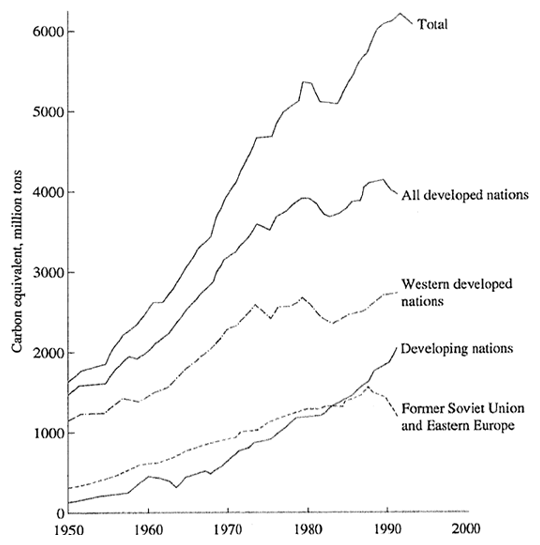
Source: Oak Ridge National Laboratory,Carbon Dioxide Information Center (United States),estimated values
According to the 1995 report of the Intergovernmental Panel on Climate Change (IPCC),the global average surface temperature has in-creased 0.3-0.6℃ since the end of the 19th century. In the same report, the results of these observations were closely examined,and they were taken to suggest that climatic change due to human activitics was al-ready taking place. If greenhouse gases continue to increase at their present rate (corresponding almost to a medium emission forecast),the average temperature of the air near the surface of the ground will in-crease about 2℃ by the end of the 21st century,and it can be predicted that the increase will continue after that (based on medium climatic sen-sitivity). This kind of temperature increase is unprecedented in the past 10,000 years and can be regarded as an extremely sudden change. Fur-ther,it has been predicted that the surface of the ocean will rise about 50cm by the end of the 21st century. Along with these changes,there is the danger of a widespread and serious effect on the living environment of humanity and other organisms. If events were to unfold according to the report,Influence of Global Warming on Japancompiled by the En-vironment Agency in September 1994,based on conditions equivalent to twice the present concentration of carbon dioxide,it can be predicted that in Japan,also,global warming will exert various harmful influences in the areas of water resources, agriculture,forestry,the ecosystem,the coastal area,energy,urban infrastructure,health,etc.
Further,the 1995 IPCC report offers a useful information base for a study on necessary future global warming countermeasures. It suggests that,in order to stabilize the concentration of greenhouse gases in the air,the future amount of emission in the entire world,in-cluding developing countries,must be reduced at least to a level far be-low that of 1990. For example,in order to stabilize the carbon dioxide concentration of the air at a level of 550 ppm or less,about twice that of the pre-industrial revolution era,the world's total emission amount from the end of the 21 st century onward must be greatly reduced from that of the present level. In view of the increase in the amount of greenhouse gases emitted which has accompanied the rapid population increase and economic growth of developing countries,the developed countries are in a position which demands still more countermeasures than the pre-sent situation,in the direction of restraint and a reduction in the amount of the world's greenhouse gas emission.
If these points are considered,before the effects of warming are visible and an irreversible condition is produced,in addition to imple-menting what are calledno-regret policies(a countermeasure with a scope that has great usefulness,even in areas other than the warming prevention effect,and is not regretted,even if warming does not occur) from a preventive viewpoint,it is important to implement countermea-sures that exceed these.
Carbon dioxide is the most important greenhouse gas. lit is pro-duced from every aspect of human activities and the situation is now one that requires a new approach,different from the pollution preven-tion up to now,in confronting the restriction and reduction of its emis-sion. Ultimately,radical measures that review and change the present mass production,mass consumption and mass disposal socioeconomic system have become necessary. The global warming problem has be-come one of the most important agenda of present environmental ad-ministration because of the difficulty of the countermeasures,in addi-tion to the great effects brought about by global warming.
B. Countermeasures
The Basic Environment Plan decided by the Cabinet in 1994, stipulates a basic policy line that strives for the steady progress in achieving the ultimate objectives of the United Nations Framework Convention on Climate Change (UNFCCC) in the long-term,contribut-ing to the creation of the international framework for that purpose in the medium-term,and for the present,implementing steadily theAc-tion Program to Arrest Global Warmingdecided in 1990. In 1995 the fol-lowing policies were carried out in conformity with this policy course.
(A) Implementation of the Action Program to Arrest Global Warming
As for Japan's global warming countermeasures,at present,vari-ous countermeasures are being promoted based on the Action Program to Arrest Global Warming (decision of the Council of Ministers for Global Environment Conservation,October 1990) that clarified Japan's basic attitude concerning global warming countermeasures. In this ac-tion program,(i) to stabilize the amount of carbon dioxide emission per capita in the year 2000 and beyond,at about the same level as in 1990,and (ii) to stabilize the total amount of carbon dioxide emission in the year 2000 and beyond at about the same level as in 1990,through progress in the development of innovative technologies at a pace and on a scale greater than currently predictedwere set as objectives,and each year the state of its implementation is reported to the Council of Ministers for Global Environment Conservation. In June 1995,the total amount of carbon dioxide emitted in 1993 and the measures related to the Action Program to Arrest Global Warming implemented in 1994 were reported to the Council. According to this report,the amount of carbon dioxide emitted in Japan in 1993 was 324 million tC (tons carbon equivalent) and the amount of emission per person was 2.60 tC. Com-pared to 1990,the emission amount per person was almost the same, and the total amount increased approximately 4 million tC. Further,the amount of Japan's carbon dioxide emission,as a gross amount,com-prised a little less than 5% of the amount emitted by the entire world, was fourth following the United States,the former Soviet Union and China (the second largest among OECD countries) and,although the amount per capita was greatly below that of OECD average,it was two or more times the average of the entire world.
In 1995 as well,many countermeasures were implemented. The main ones are as follows.
(i) In the Action Plan for Greening Government Operations decided by the Cabinet Conference in June 1995,the government took the lead in carrying out the expansion of recycling and the reduction in energy used,and,with this,stipulated that the amount of carbon dioxide that could be emitted from administrative affairs be restricted in conformity with the Action Program to Arrest Global Warming.
(ii) In 1995,when the Regional Environmental Pollution Control Pro-grams of the Hiachinohe and Niigata regions were reestablished under the direction and approval of the Prime Minister,the former framework of the Regional Environmental Pollution Control Program was extended, thus the global warming countermeasures were incorporated into these programs.
(iii) In order to promote global warming prevention countermea-sures in regions,assistance was provided with respect to developing policies such as the establishment of master plans concerning global warming countermeasures by local governments (regional promotion plans for global warming countermeasures).
(iv) In order to strengthen measures,such as energy conservation by businesses,in addition to providing guidance to businesses for the pur-pose of energy conservation in factories,etc.,according to a judgment standard based on the Law for Rational Use of Energy,low-interest fi-nancing and tax preferences,etc.,were provided with respect to spe-cific business activities (the introduction of energy saving equipment in factories,etc.) that had received approval based on the Provisional Law for the Promotion of Business Activities Concerning the Rational Use of Energy,Recyclable Resources,etc.
(v) In order to reduce the amount of waste,to increase recycling,the effective use of the surplus heat of waste incineration and the heat gen-erated during the sewage treatment process,the promotion of a model project of a sewage system that uses heat and the flotation of bonds for a solidified-waste fuel electricity generation project were carried out.
(vi) In order to form a transportation system that contributes to a re-duction and restriction of carbon dioxide emission,the promotion of a modal shift (induction to railroad transport,coastal navigation) in main line transport between long and middle distance distribution points is continuing and,in addition to the establishment of efficient distribution systems,the construction of by-passes is being carried out
Further,support has been provided for the introduction of low pollution vehicles,such as the implementation of assistance for the intro-duction of low emission vehicles as pollution patrol vehicles.
(vii) In order to form an energy supply structure that emits smaller amounts of greenhouse gas,the development and use of nuclear power premised on the assurance of safety,the use of water power and geo-thermal power,the introduction of combined cycle power generation and solar power generation have been promoted.
In order to promote the diffusion of solar power generation,a manual was developed compiling information on the technical and insti-tutional aspects necessary for its introduction in the public facilities owned and managed by local governments.
(viii) In order to devise still more appropriate countermeasures based on scientific knowledge,and to reduce the uncertainty involved with global warming,research to explain the phenomenon,forecasting and impact evaluation countermeasures,monitoring of greenhouse gases (GHGs) and the development of GHG-monitoring technology using satel-lites,have been implemented. Further,in order to promote investiga-tions and research,various measures have been devised,including the expansion of funds for the comprehensive promotion of the Global Envi-ronment Research.
(ix) In the New Sunshine Program,research has been actively pro-moted concerning the innovative technological development of a still higher level of new energy technology and energy saving technology, and the fixation and effective use of carbon dioxide in order to restrain the emission of GHGs.
(x) In order to diffuse and spread the knowledge of the Action Pro-gram to Arrest Global Warming and the countermeasures based on it, in addition to distributing pamphlets,etc.,local governments also were informed through various kinds of meetings.
(xi) Concerning international cooperation,in addition to financial and technological support for related international organizations and sup-porting developing countries in official development assistance,such as the training of experts from developing countries,the Environment Agency held the 5th Asia Pacific Seminar on Climate Change in Sendai City in Miyagi Prefecture in January 1996,in order to support efforts to tackle global warming by the developing countries of the Asia-Pacific region. Further,support has been provided for developing a national strategy to deal with global warming by developing countries in the Asia-Pacific region.
Further,in order to promote global warming countermeasures through international cooperation by municipalities,the Environment Agency in October 1995 held the 3rd Local Government Leaders' Sum-mit on Climate Change (Saitama Summit) together with the Interna-tional Council for Local Environmental Initiative (ICLEI) and the Sai-tama Prefectural Government. At this conference,the Local Govern-ment Leaders' Declaration on Climate Change (Saitama Declaration) was adopted,which proposed a campaign of climate change counter-measures that the municipalities in each country of the Asian region will jointly grapple with and a joint countermeasure project among mu-nicipalities.
(xii) Because less than five years remain until the time limit for achieving the objectives of the year 2000,the necessary studies are con-ducted at the Environment Agency and others directed towards strengthening the policies to meet the goal.
(B) Measures Based on the United Nations Framework Convention on Climate Change
The United Nations Framework Convention on Climate Change (UNFCCC) became effective on 21 March 1994. This Convention sets the ultimate objective as the stabilization of greenhouse gas concentra-tions in the atmosphere at levels such that adverse effects of human ac-tivities on the climate system are prevented,and makes various re-quirements on Contracting Parties,including preparation of inventories of emissions by sources and removals by sinks of greenhouse gases,and the drawing up of national programs for countermeasures to warming. In particular,Japan and other developed country Parties must adopt policies and measures with the awareness that bringing emission vol-umes of carbon dioxide and other greenhouse gases to earlier levels of anthropogenic emissions of carbon dioxide and other greenhouse gases not controlled by the Montreal Protocol by the end of the J.990s would contribute to the goals of the Convention. The Parties are also required to communicate those policies and measures taken to the Conference of the Parties within six months after the country has ratified the Conven-tion,and then send further communication on a periodic basis.
Japan,endeavoring to properly perform its duties under this Convention,sent a national communication based on the stipulations of the Convention to the provisional secretariat of the Convention in Sep-tember 1994.
As of August 1995,28 countries,including Japan,had sent a na-tional communication. The provisional secretariat prepared a consoli-dated report concerning the 15 countries that had sent national commu-nication as of December 1994. A detailed review of each country's na-tional communication was carried out. In Japan's case,the review was done from 3 to 7 July 1995.
The first session of the Conference of the Parties (COP) was held in Berlin in March and April of 1995. Aiming to decide policies and measures and to establish quantitative restriction and reduction objec-tives within the specific periods of the years 2005,2010 and 2020,the process was initiated to elaborate the countermeasures of the period of the year 2000 and beyond,that the stipulations under the current Con-vention are regarded as insufficient,and the conclusion that should be adopted at the third session of the Conference of the Parties in 1997 (Berlin Mandate). Further,introducing the concept of activities imple-mented jointly (AIJ) to carry out measures to prevent global warming jointly by multiple countries that are contracting parties to the Conven-tion,and establishing a permanent secretariat,etc.,were also decided.
An Ad Hoc Group was established to fulfill the Berlin Mandate (AGBM) and meetings were held in August and October 1995,and March 1996. In the meetings,that have been held on three occasions so far,discussions are proceeding in order to prepare protocols,etc.,with each country expressing their respective thoughts on what thequanti-fied emission and reduction objectivesshould be,what thepolicies and measuresshould be,and theelements of the protocols and other legal documents.
Further,the meetings of the two subsidiary organs of the UNFCCIC,namely. the Subsidiary Body for Scientific and Technological Advice (SBSTA) and the Subsidiary Body for Implementation (SBI), were held in August-September of 1995 and in February-March of 1996. In the two meetings that have been held so far,concerning the imple-mentation status of the AIJ project,the matters that each country should report to the Convention secretariat were decided,and regard-ing the content of the national communication from the developed coun-tries,the direction of improvement was decided,thus the framework that is necessary was formed.
Among these,at COP1,concerning the decision to conduct a pilot phase program of AIJ,Japan's Basic Framework for Activities Imple-mented Jointly in the Pilot Phase related to the United Nations Frame-work Convention on Climate Change (Japan Program for Activities Im-plemented Jointly) was agreed upon in a joint conference of the Secre-taries of the Council of the Ministers for Global Environment Conserva-tion and the Council of Ministers for Promotion of Comprehensive En-ergy Measures in November 1995,requiring wide ranging participation in all project constituencies such as local governments,enterprises, NGOs and public service corporations as an implementing constituency of an AIJ project. With the awareness that it is necessary to take meas-ures by promoting AIJ in the pilot phase,Japan could contribute in set-ting the standard of joint implementation under the Convention,thus in contribution to the limitation of the global emission of greenhouse gases, the Government established the Liaison Conference of Ministries and Agencies for Activities Implemented Jointly and its secretariat provid-ing the framework for Japan to promote AIJ. After that,in January 1996, the AIJ Project Application Manual,Project Application Form,and Pro-ject Evaluation Guidelines were approved by the Liaison Conference. The first public invitation to participate in the project was carried out from 1 April to 10 June 1996. Through a preparatory meeting of the Fo-rum for Promotion of Activities Implemented Jointly in March of the same year,information was presented to industrial circles,NGOs and lo-cal governments,etc.,opinions were exchanged,and active participa-tion in AIJ was urged.
(C) Cooperation with Activities in the Intergovernmental Panel on Climate Change (IPCC)
The IPCC is an international organization,established in Novem-ber 1988 under the auspices of the United Nations Environment Pro-gramme (UNEP) and the World Meteorological Organization (WMO), that compiles the latest knowledge concerning global warming predic-tions,effects and countermeasures with the purpose of giving a scien-tific foundation to global warming countermeasures. The IPCC com-piled the first assessment report in August 1990,and in February 1992 compiled its supplementary report. After that,a restructuring of the or-ganization was carried out and in October 1994,the 1994 Special Report was compiled. Further,in December 1995 the second assessment report was compiled.
Japan cooperates with the activities of the IPCC,and in January 1994 hosted a workshop on policies and measures to prevent global warming and their effectiveness in Tsukuba Science City. Further,in the new framework of the organization after restructuring,many Japa-nese researchers are actively participating and cooperating with IPCC, such as being lead authors of the second evaluation report,in addition to serving as the vice chairman of the second working group working on the influence of warming,adaptation and mitigation measures.
(2) Ozone Layer Protection
A. Summary of the Problem and the Present Situation
(A) Summary of the Problem
Most of the atmospheric ozone exists in the stratosphere,form-ing the so-calledozone layer.The ozone layer absorbs most of the harmful ultraviolet rays in solar radiation,protecting life on Earth. It has become apparent that the ozone layer is being depleted by artificial chemical substances such as chlorofluorocarbons (CFCs),halon,methyl bromide,etc. It is a concern that the depletion of the ozone layer and the accompanying increase in ultraviolet rays will result in the increase of such health risks to people as skin cancers and cataracts,and also hin-der the growth of plants and plankton.
CFGs are the substances made up of carbon,fluorine and chlo-rine atoms,and are used as solvents,refrigerants,foaming agents and propellants. Halon,which includes bromine,is mainly used in fire extin-guishers,and methyl bromide is mainly used as an agricultural chemical for soil disinfection and quarantine. Since these are chemically stable substances,they do not get broken down in the troposphere when they are released into the atmosphere,and thus reach the stratosphere where they are decomposed by the strong ultraviolet rays from the sun. This releases chlorine and bromine atoms,which then in a chain reac-tion response serve as catalysts to break down ozone molecules one af-ter another.
Once the depletion of the ozone layer by CFCs and other ozone-depleting substances (ODSs) occurs,recovery of the layer requires a long period of time. Moreover,the damage inflicted is an environmental problem of a global scale.
(B) The Present Scale of the Ozone Layer
The ozone layer,except for over tropical regions,has been ob-served to be in a depleting trend over almost the entire world,and th rate of decrease is particularly high in high latitude regions. In Japan. observation of the ozone layer is being carried out in Sapporo,Tsukuba, Kagoshima,Naha and Minamitorishima,and the trend of ozone deple-tion over Sapporo has been confirmed,while a large-scale ozone hole has been observed over the Antarctic annually for seven consecutive years from 1989 to 1995.
Besides the increase in the atmospheric concentration of CFCs having almost stopped,1,1,1-trichloroethane,which has a relatively short lifetime in the air,has shifted towards a decrease. Meanwhile, there has been an increase in the atmospheric concentration of HCFC-22,which is one of the substitutes for CFCs,and particularly since 1988, the increase has become conspicuous. All in all,the current atmospheric concentration of ozone-depleting substances is much higher than that in the 1970 s when the ozone hole was not observed over the Antarctic.
Regarding harmful ultraviolet rays,however,observation data from the four sites in Japan (Sapporo,Tsukuba,Kagoshima and Naha) show no evident increasing trend.
B. Countermeasures
(A) International Agreements and the Domestic Law
To tackle the problem of the depletion of the ozone layer,the Vi-enna Convention for the Protection of the Ozone Layer was adopted in March 1985,as was the Montreal Protocol on Substances that Deplete the Ozone Layer in September 1987. In Japan,the Law Concerning the Protection of the Ozone Layer through the Control of Specified Sub-stances and Other Measures (referred to as theOzone Layer Protec-tion Lawhereafter) was promulgated in May 1988 as a system for as-sured,smooth implementation of these accords (Figure 5-1-2). After se-curing the enactment of the domestic legislation,Japan consequently ratified the Convention and the Protocol in September 1988.
However,based on the later accumulation of scientific knowl-edge,it was found that ozone layer depletion was progressing faster than had been predicted,and that the CFC regulations then agreed were insufficient to properly protect the ozone layer. As a result,the regulations were tightened by revising the Protocol in 1990,1992 and 1995. At the review meeting of the Protocol in 1995,the regulation of HCFC and methyl bromide was tightened for developed countries,and a regulation schedule for all ozone-depleting substances for developing countries was newly introduced. The present regulation schedule is shown in Table 5-1-1.
Based on the Ozone Layer Protection Law,Japan has been carry-ing out the following measures.
Fig. 5-1-2 Items Incorporated into the Law concerning the Protection of the Ozone Layer through Control of Specified Substances and Other Measures
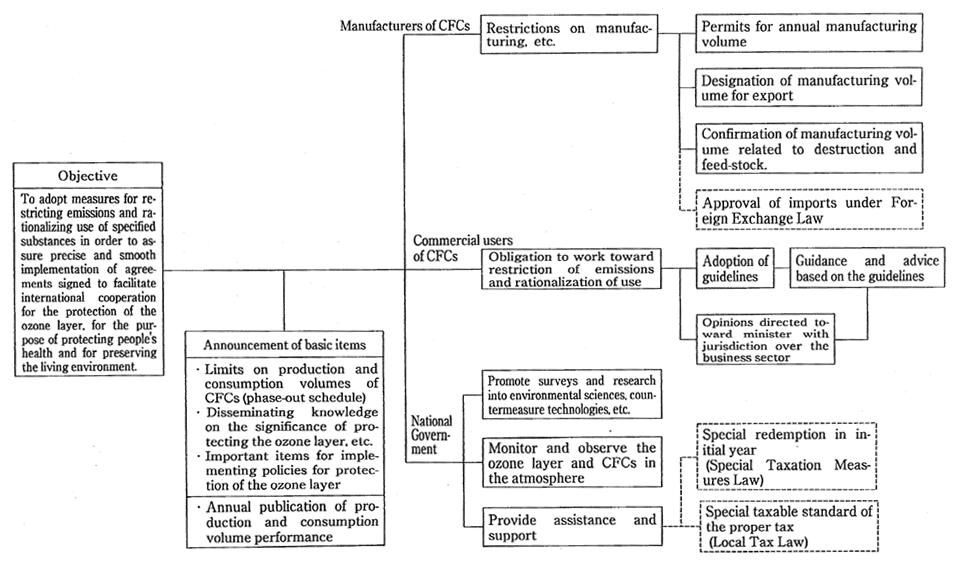
Table 5-1-1 Regulatory Schedule under the Montreal Protocol
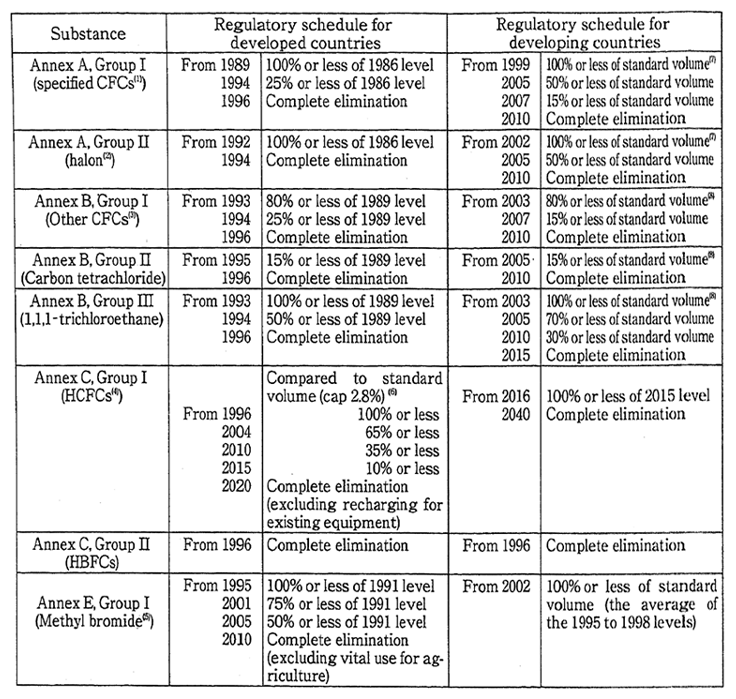
Production volume, and the consumption volume as calculated by the following formula, are to be eliminated for each substance group. Consumption volume = production volume+import volume-export volume
(1) CFC-11, 12, 113, 114, 115
(2) halon-1211, 1301,2402
(3) CFC-13, 111, 112,211, 212, 213, 214,215,216,217
(4) HCFC-21, 22, 31, 121, 122, 123, 124, 131, 132, 133, 141, 142, 151, 221, 222, 223, 224,
225, 226, 231,232,233,234, 235, 241, 242, 243, 244,251,252,253,261, 262, 271
Note that HCFCs are regulated for consumption volume only.
(5) Methyl bromide used for quarantine inspection and pre-shipment application are
exempted from the regulations.
(6) The standard volumes are calculated according to the following formula. Note
that the X% in the following formula is called the cap.
Standard volume calculated value of 1989 consumption Volume for HCPCs
+ calculated value of 1989 consumption Volume for CFCsラ(X%)
(7) The standard volume is the lower of either the average value of consumption vol-
ume for 1995 to 1997 or a consumption volume of 0.3 kilograms per person.
(8) The standard volume is the lower of either the average value of consumption vol-
ume for 1998 to 2000 or a consumption volume of 0.2 kilograms per person.
a. Production Control of CFCs, etc.
Under the Ozone Layer Protection Law, domestic production and consumption ofSpecified Substances(CFCs, Halons, Carbon tet-rachioride, 1,1,1-trichioroethane, HCFC, HBFC and methyl bromide) are controlled so that they meet the requirements of the Montreal Protocol amended in November 1992.
For example, production and consumption volume in Japan in 1995 was 24,267 tons and 23,062 tons, respectively, for CFC-11, 12, 113, 114 and 115 (referred to asspecified CFCshereafter), These are about 23.7% and 22.4% less, respectively, from the base year of the regulations (1986). The figures for CFCs other than specified CFCs were 135 tons and 135 tons, which are about 6% and 6% less, respectively, from the base year (1989) (all values are the sum of the different varieties of CFCs multiplied by each Ozone-Depletion Potential (ODP)).
b. Emission Control and Rational Use of CFCs, etc.
The Government issuedThe Guidelines for Emission Control and Rational Use of Specified Substancesin order for the business us-ers of specified substances to curb their emission and rationalize their use. The business users are being encouraged to take the appropriate measures taking the Guidelines into consideration. With regards to re-frigeration and air conditioning equipment, special tax treatment and fi-nancial measures including special redemption for the corporate and in-come taxes as well as allowing exceptional treatment for the fixed prop-erty tax are available in introducing such facilities using substitutes for specified CFCs, emission control and recovery facilities of specified CFCs for cleaning equipment. Financial support such as low-interest loans is also available from the Japan Development Bank, Japan Envi-ronment Corporation and other institutions.
(B) Promotion of Recovery, Reuse and Destruction of CFCs
At the fourth meeting of the Parties to the Montreal Protocol, held in 1992, the decision which urges the Parties to promote recovery, recycling and destruction of CFCs was adopted. Following the decision, The Council for Promoting the Protection of the Ozone Layer,which consists of 18 relevant Ministries and Agencies, was established in the Government. The Council later proposedThe Measures to Promote Recovery,Reuse and Destruction of CFCsin June 1995.
The proposal claims that,for household refrigerators,it is neces-sary to form consensus on the assignment of the roles and the sharing of the costs of recovery and destruction of CFCs by establishing,for ex-ample,a local board consisting of the parties concerned such as manu-facturers and retailers of CFCs and refrigerators,consumers,scrappers and disposers of waste refrigerators. In this context,it presents exam-ple of the assignment of the roles of the recovery and destruction of CFCs in the society (Figure 5-1-3).
Fig. 5-1-3 Example of Recovery and Destruction of Household Refrigerator CFCs in Society
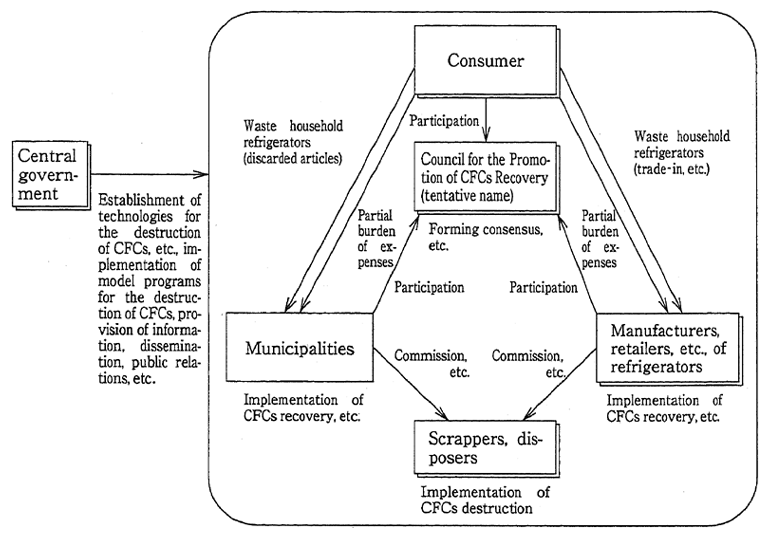
The Environment Agency informed municipalities and indus-tries of the proposal,and requested them to promote the recovery and destruction of CFCs.
As a result of this,the number of municipalities which are recov-ering CFCs from waste household refrigerators increased to 1,024 (March 1995) from 372 (March 1994),and will be expected to reach 2,068 municipalities after FY 1996. Furthermore,34 prefectures and cities had established local boards for the promotion of CFC recovery by the end of FY 1995,and another six have plans to establish them in FY 1996 or later. Thus the process for CFC recovery is now on track.
In addition,the Environment Agency carried out the following measures to promote CFC recovery.
a. CFC Recovery Model Project
As mentioned above,the promotion of CFC recovery requires the establishment of the social system in which the parties concerned are taking part in each region. Bearing this in mind,the Environment Agency has been implementing CFC recovery model projects on a trial basis with the cooperation of municipalities,which serve as references for other regions in establishing CFC recovery systems of their own. Based on the results of the model projects,the Environment Agency is-sued a handbook of a collection of CFC recovery examples and publi-cized it to the parties concerned in FY 1995.
b. Establishment of CFC Destruction Technology
Since there is an urgent need to establish technology for the de-struction of recovered CFCs and thereby to deploy CFC destruction fa-cilities,the Environment Agency had undertaken short-term CFC de-struction experiments,etc.,and appraised the feasibility of each de-struction through the evaluation of (i) the environmental effects by the products,(ii) the destruction efficiency of CFCs,and (iii) required opera-tion control conditions.
c. Promotion of Public Awareness
The Environment Agency made efforts in promoting public awareness on issues of CFC recovery especially in July,the Month for Promotion of the Protection of Ozone Layer,through pamphlets and TV programs.
The Agency also supported regional activities such as holding of seminars and making a manual for CEC recovery so that such activities could take a firm hold in local communities.
(C) Promotion of Monitoring,Observation and Research on Ozone Layer Depletion
To ensure employment of adequate protection measures for the ozone layer,monitoring and observation of the ozone layer and of the at-mospheric concentrations of CFCs and other ODSs arc promoted. Also conducted are detailed research into the mechanisms of the depletion of the ozone layer by CFCs and other ODSs,effects due to ozone layer de-pletion,monitoring of ozone vertical distribution through the use of ozone laser radar,and development of ozone monitoring technology and of models for forecasting future trends of the ozone layer.
2. Countermeasures to Problems over a Wide Area
(1) Acid Deposition Countermeasures
A. Summary of the Problem
The termacid depositionused to refer primarily to rain with a low pH that could be regarded as being produced by taking in the air pollutants,such as sulfur oxides (SOx) and nitrogen oxide (NOx) pro-duced by the combustion of fossil fuels that changed to sulfuric acid and nitric acid,etc.,in the air,but at the present time,in addition to this rain, both wet deposition,including fog and snow,and dry deposition,in the form of gas and aerosol,are together called acid deposition. When the air pollutants of SOx and NOx remain in the air,the problem of air pollu-tion occurs,but what occurs when they shift from the air and move to the water and soil is the acid deposition problem.
There is concern about the wide ranging effects of acid deposi-tion,such as that the lakes,marshes and rivers of inland water will be-come acidic and the fish will be affected,that the soil will become acidic and the forests will be affected and that acid deposition directly on trees and cultural assets will promote their decline and collapse. In Europe and the United States,where acid deposition became a problem early on, the acidification of lakes and marshes and the decline of forests that can be regarded as being caused by acid deposition has been reported. Acid deposition has the property of depositing even in regions several thou-sands of miles distant from the generating source of SOx and NOx,which is one of the characteristics of a wide area phenomenon that crosses the boundaries of countries. In order to prevent the adverse effect due to acid deposition in Europe,in 1979 theConvention on Long Range Transboundary Air Pollutionwas signed,and the related countries,in addition to promoting the reduction of substances that are the source of acid deposition,such as SOx and NOx,are jointly striving to monitor acid deposition and elucidate its adverse effect.
Acid deposition used to be recognized as problem only in devel-oped countries,but recently due to the striking idustrializaition in de-veloping countries the amount of air pollutant emissin is increasing and,in addition to regional air pollution. wide area acid deposition is also becoming a big problem.
InAgenda 21,adopted at the Earth Summit,measurcs to han-die wide area environmental problems,such as acid deposition,are re-garded as requiring strengthening,not just in developed countries,but in developing countries as well,from now on.
B. Countermeasures
In Japan,following the first investigation on acid deposition (1983-1987),the second investigation (1988-1994) was carried out. A summary of the findings of the second investigation is as follows.
(i) The pH in inland water and th ion deposition amount are chang-ing at about th same level as in Europe and the Unitcd States,and dur-ing the investigation no conspicuous fluctuations were seen.
(ii) Conccrning th influence of acid deposition on rivers,due to liqui-dation of the acidic components. the pH of meIted snow water shows a temporary tendency to decrease,but due to the mediation action of soil while flowing into rivers,no conspicuous influence on rivers is seen.
(iii) Concerning th influence of acid deposition on vegetation,the de-cline of trees in several investigated regions was recognized,but deter-mining whether or not acid deposition contributed to this decline re-quires further diversified research and investigation.
In this way,at th present time the influence on th ecosystem due to acid deposition in Japan has not become clear,but there are also many unclear points about the Iong-term effects on inland water,soil and vegetation and there is concern that if acid deposition as it is at the present continues to fall from now on,in th future will be the pos-sibility that an influence due to acid deposition will appear.
For this reason,beginning in FY l993,a five-year study is being carried out on a simulation modeI related to the generation,transfer and deposition of acidic substance,as the third investigation on acid deposi-tion,in addition to the continuous monitoring of precipitation,inland water,soil and vegetation,and to the development of models to forecast various types of effects and planning the enhancement of research and investigations,such as th comprehensive investigation of inland water, air pollutants,soil and vegetation in region in which the decline of for-ests and the relation with a acid deposition has been pointed out,
In FY 1995. as part of the third investigation, quality control ac-tivities targeting prefectural research institutes were implemented, in addition to continuous monitoring, besides implementing the develop-ment of models to forecast the occurrence of acid deposition and models to predict adverse effects on soil and vegetation due to acid deposition and implementing comprehensive surveys concerning the relationship of decline of forests and acid deposition, and in order to plan for the im-provement of quality control activities for acid rain in measurement. Fur-ther, one acid deposition monitoring sit was additionally equipped. A monitoring project of forest destruction caused by acid deposition also started in FY 1990, and besides the implementation of a survey of the current status of the decline of forests due to acid deposition on a na-tional scale, since FY 1995 observation of the chemical components of precipitation and falling dust has started at the Minamitorijima global observation site as a part of the Global Air Watch (GAW) project pro-moted by the WMO.
Further, internationally, Japan advocated theAcid Deposition Monitoring Network in East Asiaas the first cooperative measure in the East Asian region and since FY 1993 has obtained the participation of experts from related countries and international organizations, has held theExpert Meeting Concerning Acid Deposition Monitoring Net-work in East Asia.At the third meeting held at Niigata in November 1995,the conceptual design of the network was adopted (for details see Chapter 9 Section 5,3).
(2) Photochemical Mr Pollution Countermeasures
A. The Present State of Photochemical Air Pollution
(A) Results of the Measurement of Photochemical Oxidants in FY 1994
Photochemical oxidants measurement data in FY 1994 was ob-tained from 1,120 General Air Pollution Monitoring Stations (APMSs) in 627 cities, towns and villages, and at 39 Roadside Air Pollution Monitor-ing Stations (RAPMSs) at 25 cities, towns and villages.
The state of photochemical oxidants is progressing in a severe state as before, and for APMSs and RAPMSs together, the number of stations at which the highest value of the one hour midday (5a.m.-10p.m) value was 0.06 ppm (environmental quality standard) or less, and the number of stations at which it was less than 0.12 ppm (caution report level), are as in Table 5-1-2.
Table 5-1-2 Trend in the Number of Air Pollution Monitoring Sta-tions for Each Level of Photochemical Oxidant Density (Total of General Stations and Roadside Stations)

Source:Environment Agency
(B) The State of Photochemical Oxidant Warning Announcements, etc., in 1995
a. The State of National Warning Announcements
Announcements of photochemical. oxidant warnings (announced when the one hour value of the concentration of photochemical oxidants is 0.12 ppm or more, and judging from the meteorological conditions, the pollution condition is recognized as continuing) in 1995 totaled 139 days (19 prefectures, except Hokkaido) and decreased 36 days from the 175 days (19 prefectures, except Hokkaido) of 1994. The number of an-nouncement days in the past 10 years repeatedly increased and de-creased each year and 1995 was the fifth from the highest (Table 5-1-3).
The breakdown by month of the total number of days of an-nouncements in 1995 is seven days in May. six days in June, 56 days in July, 65 days in August and five days in September.
Table 5-1-3 Trend in Number of Days with Photochemical Oxidants Warnings WereIssued and in Number of People Who Re-ported Damages (1990-1995)

Source:Environment Agency
The highest concentration of photochemical oxidants during the days of warning announcements in 1995 was 0.241 ppm. At that time there was no announcement of a photochemical oxidant alarm. (The standards are different depending on the local government body, but normally an announcement is made when the one hour value of photo-chemical oxidants is 0.24 ppm or more, and, judging from the meteoro-logical conditions, the pollution condition is recognized as continuing.)
b. Breakdown of Warning Announcements by Block
When the total number of days of warning announcements in 1995 is looked at, it was 101 days in the Tokyo Bay block (the one metro-politan district and six prefectures of Ibaraki Prefecture, Tochigi Pre-fecture, Gumma Prefecture, Saitama Prefecture, Chiba Prefecture, To-kyo Metropolitan District and Kanagawa Prefecture), and 14 days in the Osaka Bay block (the four prefectures of Kyoto, Osaka, Nara and Hyogo) and these two regions occupied about 83% of the total.
c. Number of Persons Reported Injured
The number of people who reported an injury that appeared to be due to photochemical air pollution in 1995 (according to voluntary re-ports due to an awareness of symptoms) was 192, and, although it was a large decrease from the 564 persons of 1994, the number of persons who have reported injury over the past 10 years has conspicuously in-creased and decreased each year and a uniform trend cannot be recog-nized.
(C) Result of the Measurement of Non-methane Hydrocarbon in FY 1994
In August of 1976,Concerning the Guidelines for the Concentra-tion of Hydrocarbons in the Air for the Purpose of Preventing the Crea-tion of Photochemical Oxidantswas published by the Central Pollution Countermeasures Deliberation Council. In this article, concerning the measurement of hydrocarbons, non-methane hydrocarbon was meas-ured and the average three hour value, from six to nine in the morning, of the concentration of non-methane hydrocarbon that corresponded to a one hour value of 0.06 ppm, which is the environmental quality stan-dard for photochemical oxidants, was regarded sa in the range of 0.20-0.31 ppmC(ppmC is the ppm value expressed with the number of car-bon atoms as the standard).
a. General Air Pollution Monitoring Stations (APMSs)
The measurement data of non-methane hydrocarbon in FY 1994 was obtained at 358 stations in 252 Cities, towns and villages. The change over the years of the average annual value in the hours of 6-9a.m. at six stations that carried out measurements continuously from 1978 are as in Table 5-1-4
b. Roadside Air Pollution Monitoring stations (RAPMSs)
The non-methane hydrocarbon measurement data in FY 1994 was obtained at 179 stations in 116 cities, towns and villages. The change over the years of the average annual value in the hours of 6-9a.m. at nine stations that carried out measurements continuously from 1977 are as in Table 5-1-4.
Table 5-1-4 Trend in the Annual Average Values for Non-methane Hydrocarbons Monitored between the Hours of 6-9a.m. at Continuous Monitoring Stations

Source: Environment Agency
B. Countermeasures
The concentration of photochemical oxidants, as before, ex-ceeded the environmental standard in most regions of th nation, and, because the reality of the situation is that warnings arc announced de-pending upon the meteorological conditions, from now on there is also a necessity to accurately comprehend the progress of the pollution situ-ation and to devise suitable countermeasures.
(A)Photochemical Air Pollution Emergency Measures
In order to obtain the meteorological data that is necessary to de-termine whether to make warning announcements,the Environment Agency observes the weather at four sites in the two blocks of Tokyo Bay and Osaka Bay,in which photochemical air pollution easily occurs in the summer season,and provides the weather information to the local government bodies concerned. Further,the Meteorological Agency at 19 Meteorological Agency offices nationwide analyzes and forecasts the meteorological conditions that are liable to generate photochemical air pollution and,in addition to notifying local government agencies,an-nounces smog weather warnings,as necessary,and enables them to be-come widely known by the people of the country. Based on these re-ports and monitoring station data,the local government bodies,at the same time as announcing warnings according to the photochemical oxi-dant emergency countermeasures outline,devise a publicity campaign for residents,in addition to calling on those who emit soot and smoke to reduce the amount of air pollutants emitted,and on automobile users to refrain from driving their cars when it is not neccssary or an emer-gency.
(B) Countermeasures for Hydrocarbon Emission Restraint
a. Countermeasures for the Restraint of the Emission of Hydrocarbons from Stationary Sources
At the Environment Agency in July 1982Concerning the Pro-motion of Countermeasures to Hydrocarbons for the Purpose of Pre-venting Photochemical Air Pollutionwas decided for the purpose of promoting and strengthening countermeasures to restrain the emission of hydrocarbons with respect to stationary sources,based on the results of the investigation concerning the evaluation of emission prevention technology and the comprehension of the actual emission situation in the committee to study countermeasures to permanent hydrocarbon generating sources. The Environment Agency,based on these guide-lines,carried out the required call for the promotion of hydrocarbon emission restriction countermeasures with respect to the areas related to local government bodies.
b. Countermeasures for the Reduction of Hydrocarbon Emission from Automobiles
Regulations have been implememted since 1970 concerning hy-drocarbons emitted from automobiles. Concerning gasoIine-and LPG-fueled passenger cars,the amount of hydrocarbons emitted per vehicle decreased 92% compared to th unregulated period.
(C) The Promotion of Photochemical Air Pollution Survey Research
Photochemical air pollution is extremey complex phenome-non extending over a wide area,and survey research is being carried out in many ar as such as the photochemical reaction mechainism,the influence of the weather,such as advection diffusion,the emssion situ-ation of root cause substances,a photochemical air pollution forecasting model that incorporates these and,further,the influence of photochemi-cal oxidants on vegetation.
3. Countermeasures to the Problem of the Accumulation of Burdens on Large Metropolitan Areas,etc.
(1) Nitrogen Oxide Countermeasures
A. The Present State of Air Pollution Due to Nitrogen Oxide
(A) Changes in the Annual Averege Value of Nitrogen Dioxide
In FY 1994,as for valid monitoring stations (meaning monitoring stations with 6,000 hours or more Of annual monitoring time,the same applies below) concerned with nitrogen dioxide,there were 439 General Air Pollution Monitoring Statrons (hereafter calledAPMSs)in 691 cit-ies,towns and villages,and th re were 363 Roadside Air Pollution Moni-toring Statrons,(hereafter calledRAPMSs) in 210 cities,towns and vil-lages.
The progress of the annual average value at continuous monitor-ing stations (1,160 APMSs,239 RAPMSs ) of th past 10 years is as in Fig-ure 5-1-4 In 1994 it was 0.017 ppm at APMSs and 0.034 ppm at RAPMSs, unchanged from 1993,and was progressing at high level as before.
Fig. 5-1-4 Trend of the Annual Average Values for Nitrogen Dioxide
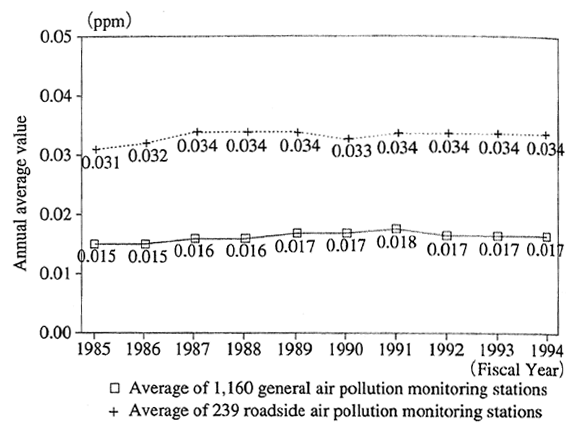
Source: Environment Agency
(B) The State of Suitability of the Environmental Quality Standard Regarding Nitrogen Dioxide
Concerning the environmental quality standard regarding nitro-gen dioxide,according to Environment Agency Notification 38 of July 1978 (hereafter calledNotificationin this section),in addition to re-gardingthe one day average value of a one hour value as in a zone from 0.04 ppm to 0.06 ppm or less,it stated that in the regions where the one day average value of a one hour value (hereafter called theone day average value) exceed 0.06 ppm,as a rule,an effort should be made so that 0.06 ppm is achieved within 1995,and in regions where the one day average value is in a zone from 0.04 ppm to 0.06 ppm,as a rule, the level of the present standard should be maintained,or an effort should be made so that this does not greatly exceed. An evaluation,ac-cording to the environmental standards,is carried out comparing the standard value with the value corresponding to the value of 98th per-cent,counting from the lowest measured value among the one day aver-age values in a year (hereafter called thevalue of 98% of the one day average value during the year).
Concerning the valid monitoring stations in FY 1994,the changes of the state corresponding to the environmental quality standard are as in Figure 5-1-5.
When the monitoring stations at which the value of 98% of the one day average value during the year exceeds 0.06 ppm,which is the upper limit of the environmental standard zone (stations that do not achieve the environmental quality standard),are looked at,in FY 1994 they were 4.3% of the APMSs and 32.6% of RAPMSs,about the same as in 1993,and centering on the large urban areas,the state of achieve-ment of the environmental standard was progressing at a low level as before.
(C) Trend of the Regions That Are within the Partitioned Zone Based on the Nitrogen Dioxide Environmental Quality Standard
Concerning the trend of the concentration of nitrogen dioxide in regions in which the one day average value of nitrogen dioxide is re-garded as being within a zone of from 0.04 ppm to 0.06 ppm,the states of 1977 that correspond to the standard of the present condition in 2 of Notification 2 and from FY 1990 to FY 1994 are given in Table 5-1-5.
(D) Conditions Appropriate to the Environmental Quality Standard Related to Nitrogen Dioxide in the Automobile NOx Law Specified Areas.
Based on theLaw Concerning Special Measures for the Total Emission Reduction of Nitrogen Oxides from Automobiles in Specified Areas(1992 Law Number 70,hereafter called theAutomobile NOx Law),regions in which ensuring the environmental quality standard by means of the former measures is recognized as being difficult,be-cause they are regions in which automobile traffic is concentrated,are designated as specified areas and various measures are being imple-mented based on this law. The changes in the number of stations that did not achieve the environmental quality standard related to nitrogen dioxide in the specified areas are given in Table 5-1-6.
(E) Changes of the Annual Average Value of Nitrogen Monoxide
The number of valid monitoring stations concerned with nitro-gen monoxide in FY 1994 was 439 APMSs in 691 cities,towns and vil-lages and 363 RAPMSs in 210 cities, towns and villages. When the an-nual average values at continuous stations (28 APMSs, 21 RAPMSs) from 1971 are looked at, the 0.021 ppm of FY 1994 at AIPMSs was almost the same when compared to FY 1993, and at RAPMSs the 0.055 ppm of FY 1994 was somewhat lower compared to FY 1993.
Fig. 5-1-5 Trend in Conformity to Environmental Quality Standards for Nitrogen Dioxide
General air pollution monitoring stations
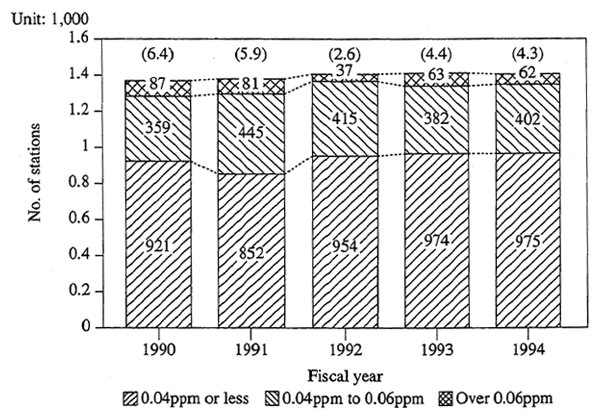
Note 1:Figures within parentheses show the ratio (%) of stations that exceed 0.06ppm
Roadside air pollution monitoring stations
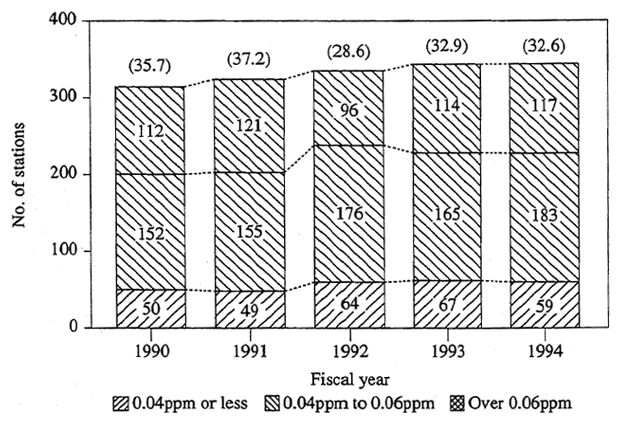
Note 2: Figures within parentheses show the ratio (%) of stations that exceed 0.06ppm
Source:Environment Agency
Table 5-1-5 Trend in Nitrogen Dioxide Density in Regions that Fall within the 0.04 ppm to 0.06 ppm Zone of Daily Average Values (General Air Pollution Monitoring Stations)
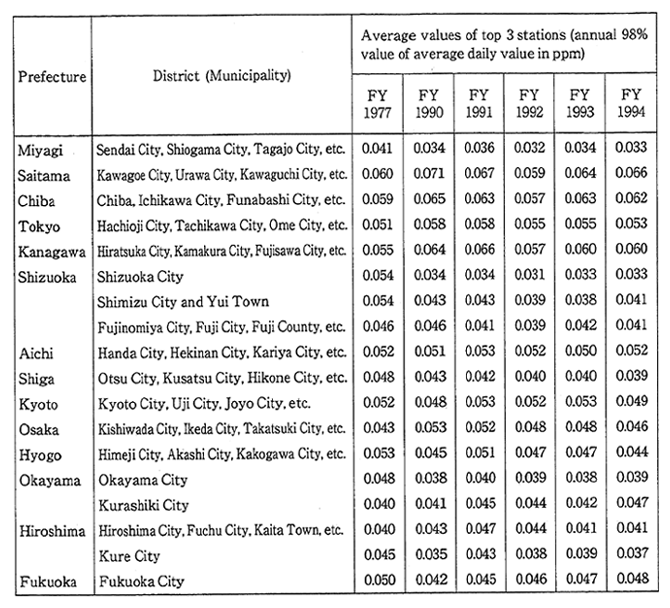
Source:Environment Agency
Table 5-1-6 Attainment State of Environmental Quality Standards for NO2at Roadside Air Pollution Monitoring Stations in Metropolitan Districts (Specified District Control Automobile NOx)

Source:Environment Agency
B. Automobile Exhaust Gas Countermeasures
Centering on major cities, one reason why the improvement of air pollution due to nitrogen oxides does not progress is the problem of motor vehicle exhaust gases. The amount of exhaust gas from automo-biles cannot be expected to conspicuously decrease because the effect of the simple regulation that has been promoted for motor vehicles themselves up to now has been offset by the striking growth in the amount of motor vehicle traffic (Figure 5-1-6) and to the increase in the percentage of diesel-powered vehicles among freight vehicles. There-fore,the following countermeasures are being comprehensively pro-moted.
Fig. 5-1-6 Trend in Automobile Ownership
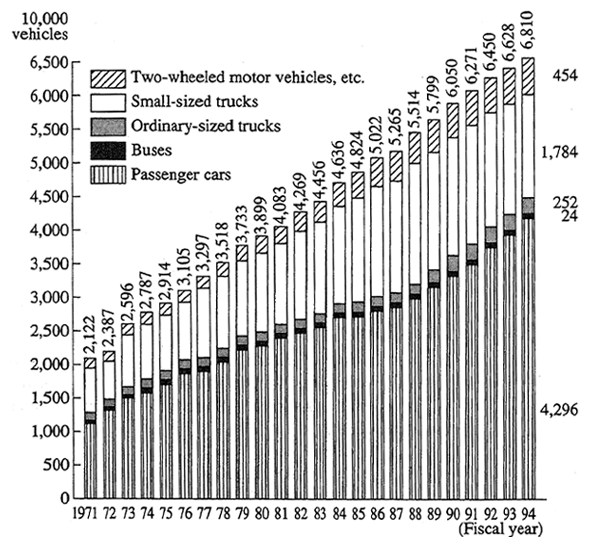
Notes: 1. Passenger cars include mini-sized passenger cars
2. Small-sized tracks include mini-sized trucks
Source:Ministry of Transport, Annual Statistics on Automobile Transport
(A) Improvement of the Automobile Structure,etc.
Concerning motor vehicle exhaust gases,since 1973,regulations have been gradually strengthened,and the amount of air pollutants emitted from each vehicle has come to be greatly reduced. Recently,in December of 1989,a report with the following content was compiled by the Central Council for Environmental Pollution Control and it is being implemented through target values in two stages,short-term (within five years) and long-term (within 10 years) (Table 5-1-7).
a. Significant Reduction of Nitrogen Oxides
(i) 30% to 60% reduction of nitrogen oxides emission from diesel-powered motor vehicles,etc.
(ii) Reduction of emissions level of direct injection type engines to the same level as that of indirect injection type engines
(iii) Setting of a reduction target that aims at a reduction to the same level of gasoline-fueled motor vehicles and diesel-powered motor vehicles in the future
b. Drastic Reviewing of Measures for Particulate Matters
(i) Introduction of new measures to reduce particulate matters and a reduction of the emission level by over 60%
(ii) Reduction of the exhaust level of diesel black smoke by half
c. Reduction of the Sulfur Content in Diesel Fuel to One-tenth Level over Two Stages
d. Reviewing of Measuring Procedure
In line with this report,concerning the short-term target,a strengthening of the regulations is being implemented by 1994. Further, concerning the long-term target,the Investigation Committee for Motor Vehicle Exhaust Emission Control has been in session since October of 1990 continuously evaluating technology aiming at its early achieve-ment. After receiving the report of this investigation committee in June of 1992,regulations were strengthened in 1994 concerning gasoline-fueled medium-duty motor vehicles and in 1995 concerning gasoline-fueled heavy duty motor vehicles. Meanwhile,concerning diesel-fueled motor vehicles,in the reports of this committee of August 1993,October 1994 and November 1995,they were evaluated as being able to achieve the long-term target from 1997 to about 1999. With the exception of large trucks and buses over 12 tons in gross vehicle weight,a notice re-vision for the purpose of strengthening regulations was carried out in January 1996. The long-term target was evaluated to be achieved for all vehicle models within the time limit as set forth by the report of the Central Council for Environmental Pollution Control.
Table 5-1-7 Outline of Target Values Recommended by the Central Council for Environmental Pollution Control in 1989
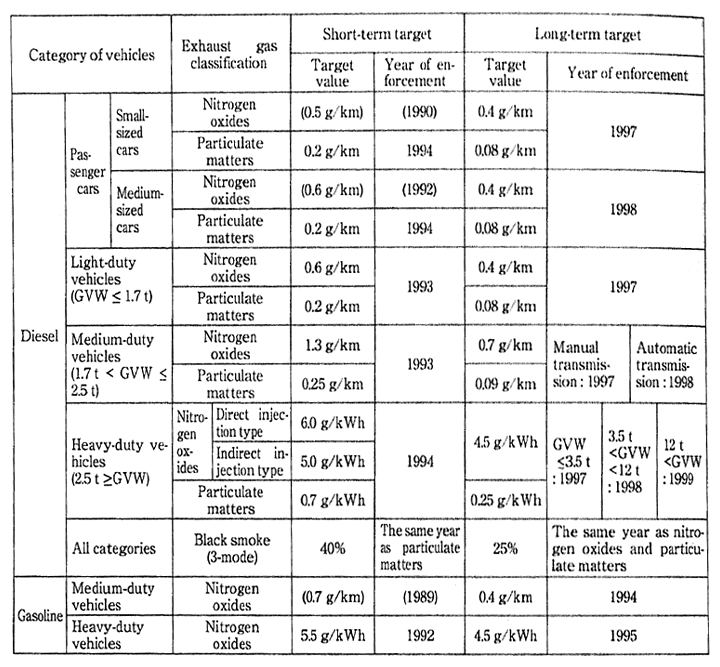
Notes: 1. Terms in parentheses were not subjects for the 1989 recommendation,and
therefore show the latest current values.
2. In passenger vehicles,hsmall-sized vehiclerefers to an equivalent inertial
weight of 1.25 tons (vehicle weight of 1.265 tons) or less,whilemedium-
sized vehiclerefers to an equivalent inertial weight of 1.25 tons (vehicle
weight of 1.265 tons) or more.
3. GVW stands for gross vehicle weight.
Further,it has become clear that two-wheeled vehicles and off-road vehicles,that are not subject to the present motor vehicle exhaust emis-sion regulations,contribute to a considerable extent to air pollution due to hydrocarbon and nitrogen dioxide. Concerning two-wheeled vehicles, the draft of a proposed law revising part of the Air Pollution Control Law that would make them subject to the motor vehicle exhaust emis-sion regulations was submitted to the 136th Diet session.
Further,in order to promote the reduction of the sulfur content of diesel fuel,concerning the prescribed equipment obtained by the pe-troleum refiners,measures to reduce the income tax,corporate tax and fixed assets tax have been implemented.
Further,in the midst of still more liberalization of the market,the Provisional Measures Law on the Importation of Specific Kinds of Petro-leum Products was abolished with the March 1996 expiration of the term,and the extent of importers of petroleum products (gasoline,diesel fuel and kerosene) was expanded. Meanwhile,there are measures to control air quality,based on a prescribed quality of petroleum products, and there is concern about a harmful influence on air quality occurring if petroleum products of an inferior quality come in due to an expansion of the importers. For this reason,a law revising a part of the Air Pollu-tion Control Law for establishing regulations for the quality of automo-tive fuel and the national efforts to reduce motor vehicle exhaust emis-sions and so on was promulgated in April 1995. Therefore,the Environ-ment Agency set forth the permissible limits of the automotive fuel quality,which were announced in October 1995.
(B) Automobile NOx Law
The annual average value of the nitrogen dioxide concentration of FY 1994 in the specified areas of Automobile NOx Law was almost the same level as compared with that of FY 1993,and the achievement rate of the environmental quality standard was 80.3% at general air pol-lution monitoring stations and 35.5% at roadside monitoring stations, both remaining at low levels. According to the estimated amount of ni-trogen oxides emitted in these areas,classified by source of generation, the percentage of emission from automobiles was 71% in Tokyo and 56% in Osaka (1990). This indicates that the contribution of emission from automobiles to the total amount of nitrogen oxides emitted is sig-nificant.
In view of this situation,in order to improve nitrogen oxide pollu-tion in major cities,based on the Law Concerning Special Measures for Total Emission Reduction of Nitrogen Oxides from Automobiles in Specified Areas promulgated in 1992,further efforts have been made to reduce the total amount of the nitrogen oxides emitted from automo-biles in specified areas.
Based on NOx Emission Reduction Plans which are the concrete plans for the purpose of reducing nitrogen oxides from automobiles in specified areas under the Automobile NOx Law,various measures have been taken switching from private trucks to commercial trucks to im-prove transport efficiency;optimizing the delivery routes in the trans-port areas suitable for private trucks;improving transport efficiency by increasing the size of trucks; physical distribution countermeasures that aim to reduce the total number of trucks b ing driven by improv-ing the effectiveness of joint transport and delivery of goods;and as traffic flow countermeasures aiming for the dispersion and harmoniza-tion of traffic,the improvement of the structure of intersections,the preparation of traffic management systems,the construction of loop roads while considering environmental conservation,etc.,and individual trip control countermeasures aiming to reduce the total us of private automobiles by improving convenience and construction of public trans-portation facilities. [See also 5Countermeasures to Problems Concern-ing the Regional Living Environment,and (1) A. Automobile Traffic Noise and Vibration Countermeasures of this chapter.]
Further,harmonious implementation is aimed at restrictions for using designated types of vehicles limiting the use of trucks and buses, etc.,which do not conform to the specially designated automobile ex-haust standards concerning trucks and buses,etc.,that mainly travel in a specified area.
Besides this,various active measures are being taken by giving preferential treatment in taxation measures,utilizing the fund sup-ported by the Pollution-Related Health Damage Compensation Law,etc., to promote activities such as: strengthening of emission control of each automobile;promoting the switch to vehicles satisfying the latest emis-sion standards;and introducing and promoting low-emission vehicles such as electrical cars,natural gas vehicles,etc.
(C) Promotion of the Low-emission Vehicles
Various measures are being implemented for promotion of low-emission vehicles such as,promoting development of technologies to im-prove their performance;providing support to lower the price;promot-ing construction of the infrastructure (fuel supply facilities);taking the lead in introducing low-emission vehicles for official cars;and so on.
In connection with the promotion of technology development,ag-gressive promotion of the development of next generation batteries for electric vehicles,research and development for the practical use of CNG vehicles,field surveys of low-emission vehicles conducted by private businesses in major cities and trial use of electric vehicles for official use by the Environment Agency are being implemented. Further,a unified evaluation of the exhaust gas of each type of low-emission vehicle was carried out with the purpose of promoting the development of low-emission vehicles,and technical guidance for emission control technol-ogy guidelines as development objectives were decided upon in June 1995.
Measures to support lowering the price of low-emission vehicles include financial aid to local public entities for introducing these vehi-cles for their pollution monitoring cars;financial aid for introduction of these vehicles using the Fund established by the Pollution-Related Health Damage Law;financial aid for private bus companies to support their programs to introduce low-emission buses ; reduced local taxes such as automobile acquisition tax,etc.;and special depreciation case or tax deductions for the purchase of these vehicles.
Concerning promoting construction of infrastructures,besides preparing 37 fuel supply facilities by 1994 in accordance with the Ecostation 2000 Plan,relaxation of legal regulations related to the es-tablishment of fuel supply facilities are being promoted.
Concerning taking the lead in introducing low-emission vehicles,in theAction Plan for Greening Government Operations, among the offi-cial vehicles owned by the government for ordinary official use,the ob-jectives of increasing the percentage of low-emission vehicles to about 1096 in FY 2000 and the introduction of low-emission vehicles to the official-use vehicles in the Environment Agency,etc.,are being pro-moted.
In addition,an international symposium related to promotion of low-emission vehicles was held in January 1996 and dissemination ac-tivities have been aggressively carried out,such as holding theLow-emission Vehicle Fair,where all types of low-emmission vehicles were exhibited to let the public learn more about them,held in eight areas na-tionwide including Tokyo Yoyogi Park. Table. 5-1-8 shows a list of meas-ures taken to promote and advance low-emission vehicles.
C. Stationary Source Countermeasurs
(A) Implementation of National Uniform Exhaust Regulations
Concerning national uniform exhaust regulations with respect to stationary sources of nitrogen oxide,since the first regulation of August 1973,besides strengthening the emission standard five times,review is being carried out gradually,adding facilities that have a high level of ni-trogen oxide emission and cannot be overlooked from the viewpoint of preventing air pollution as subject of regulation.
(B) Implementation of Total Amount Regulation
Concerning regions acknowledged as difficult to achieve the en-vironmental standard concerning nitrogen dioxide by emission regula-tions for each soot and smoke generating site,the factories and places of business are aggregated (the three regions of the Tokyo special district region,the Yokohama region and the Osaka region) and total amount regulation,concerning nitrogen oxide regulated t the unit of a factory based on the total amount reduction plan created by the prefectural governors,has been implemented since 1982.
(C) The State of Development of Nitrogen Oxide Emission Reduction Technology
Concerning technology to reduce nitrogen oxide emitted from stationary sources,there are low NOx combustion technology and emit-ted smoke dinitration technology,etc.
In low NOx combustion technology there are the two stage com-bustion method,the recirculation of exhaust gas (EGR) and the low-NOx burner,etc.,and by using these technologies,boilers that have the effect of reducing the emission of nitrogen oxide to a considerable extent are becoming widespread.
When exhaust smoke dinitration technology is looked at,as can be seen in Figure 5-1-7,the number of installations of exhaust smoke dinitration equipment and the processing capacity are steadily increas-ing. As a dinitration method, many use the dry selective catalytic reduc-tion method.
Table 5-1-8 Current State of Low-emission Vehicle Dissemination and Promotion Policies by the National Government
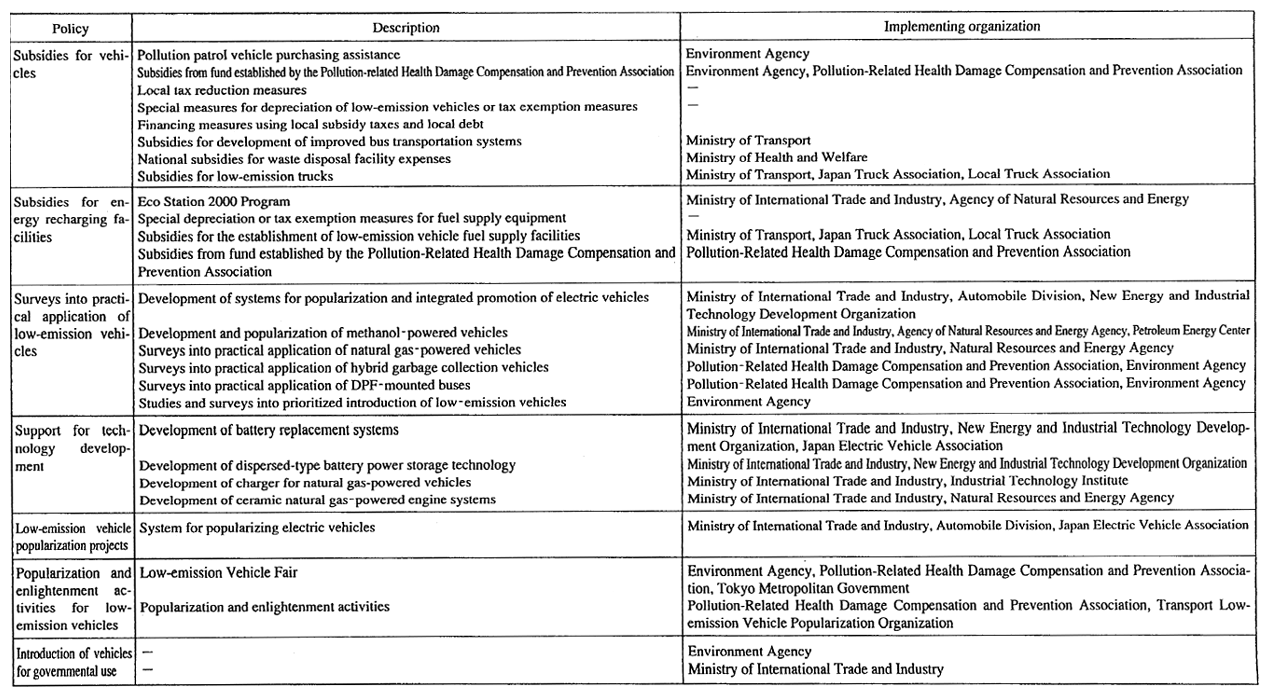
Source:Environment Agency
Fig. 5-1-7 State of Installation of Smokestack Denitrification Equipment
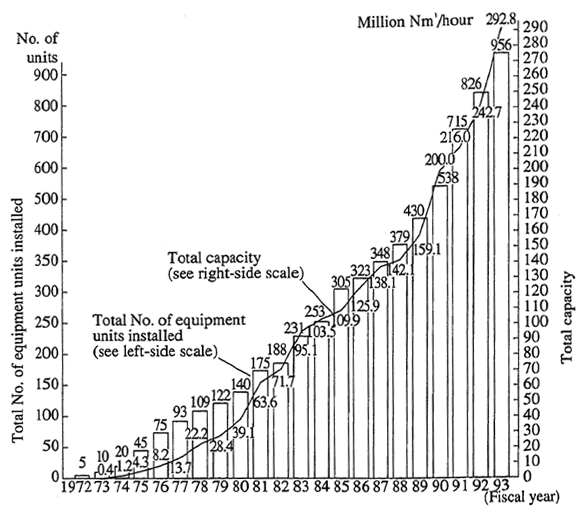
Note: Figures through fiscal year 1982 are for 1 January of each year, while figures for fiscal year 1983 and onward are for 31 March.
Source:Environment Agency
(D) Other Countermeasures
Also, concerning small-scale combustion equipment such as small boilers for business use that do not come under the soot and smoke emitting facility stipulated by the Air Pollution Control Law, particu-larly, since the amount of nitrogen oxide emitted from these in major cities cannot be ignored, a NOx emission guideline value as a standard for recommending excellent products and policies to promote the diffu-sion of equipment that conforms to it are being studied.
D. Ship and Aircraft Countcrmeasures
Concerning nitrogen oxides,sulfur oxides and CFCs,etc.,emitted from ships,at present no regulations have been enacted,but in the In-ternational Maritime Organization (IMO) at the present time concrete study is being done concerning the addition of a new annex,related to the regulation of exhaust gas from ships,to th International Conven-tion for the Prevention of Pollution from Ships,1973,as modified by the Protocol of 1978 relating thereto (MARPOL 73/78 Convention) aiming at adoption in 1997. Further,in Japan also,in cities that have large harbors, because there is also the possibility that the air pollution from ships from now on will become something that cannot be ignored. studies ar being conducted to comprehend the actual situation of mission from ships,the trends in emission reduction technology and emission reduc-tion methods that have coped with the international trend.
Further,concerning nitrogen oxides,hydrocarbon,carlon mon-oxide,smoke and soot emitted from aircraft,in the International Civil Aviation Organization (ICAO)a standard has been establish d as an emission source countermeasure,and in February 1996 the draft of leg-islation partly revising the Aviation Act,with the content that if an air-craft does not conform to this standard it cannot be supplied for use in aviation,was submitted to the 136 th session of th Diet.
E. Other Countermeasures
In addition to the various countermeasures above,since 1988,in order to deal with a high concentration of air pollution in winter,besides implementingseasonal air pollution countermeasureswith the con-tent of rationalizing heater temperatures ind reducing th use of official vehicles,the month of December was madeAir Pollution Prevention Promotion Monthtargeting a wide range of citizens,and in order to prevent air pollution,popularization and education activities have been implemented,such as appeals to promote the use of public transporta-tion.
Further,as measures to prevent health damage due to the influ-ence of nitrogen oxide air pollutants,various projects to contribute to the improvement of regional air environment,financed by the Pollution Law Foundation,are promoted (such as the introduction of low pollution vehicles,like electric automobiles and natural gas automobiles,carried out by local government bodies,the promotion of switching to vehicles that conform to the latest regulations with less exhaust gas and the pro-vision of vegetation with the capability of clecaning the air).
Further, as a countermeasure to the exhaust gas that accompa-nies construction work, the development and populrization of exhaust gas countermeasure type construction equipment is promoted.
(2) Countermeasures to Suspended Particulate Matter, Minute Particles of Diesel Exhaust
A. Countermeasures to Suspended Particulate Matter and Minute Particles of Diesel Exhaust
Particulate matter in the air is roughly classified into falling sootandfloating dust. Floating dust is further classified into Sus-pended particulate matter that has a particle diameter of 10 microme-ters or less, which has been established by the environmental quality standard, and that which does not. The sources that generate these kinds of particulate matter are not just related to industrial activity such as factories and places of business. Some is generated along with the operation of an automobile such as automobile exhaust and what is thrown up by tires. And some are due to natural phenomena such as the particles of soil blown up by the wind. Among these virious genera-tion sources, concerning the occurrence that accompanies business ac-tivity in a factory and place of business, based on the Air Pollution Pre-vention Law,(i) substances generated in conjunction with the use of electricity as a heat source or the combustion of fuel or another sub-stance are regulated as soot and (ii) substances generated accompa-nying the destruction of something, sorting and some other mechanical processing, or generation accompanying accumulation, or scattered sub-stances are regulated asdust.Further, what is generated accompany-ing the operation of an automobile is regulated asparticulate matter based on the same law.
(A) The Present State of Air Pollution Due to Suspended Particulate Matter and Minute Particles of Diesel Exhaust
a. The Present State of Air Pollution Due to Suspended Particulate Matter
The number of valid monitoring stations concerning suspended particulate matter in FY 1994 was 1,485 general air pollution monitoring stations in 689 cities, towns and villages and 211 roadside air pollution monitoring stations in 146 cities, towns and villages. (Figure 5-1-8)
The change in the annual average value at continuously measur-ing sites in the past 10 years (659 general air pollution monitoring sta-tions, 54 roadside air pollution monitoring stations) is as in Figure 5-1-9, and FY 1994, at 0.037 ppm for general air pollution monitoring stations and 0.048 ppm for roadside air pollution monitoring stations,became a little high when compared to FY 1993.
b. Conditions That Conform to the Environmental Quality Standard Concerning Suspended Particulate Matter
The environmental quality standard concerning suspended par-ticulate matter was established in January 1972. When, in a long-term evaluation of the environmental standard, the value excluding those in the range of 2% from the upper measurement value among the one day average values in a year is 0.10mg/m3 or less, and there are not two or more days in succession that exceed the one day average value of 10 mg/3 a year, it is regarded as conforming to the environ-mental quality standard.
The change in the rate of achieving the environmental quality standard based on a long-term evaluation is as in Figure 5-1-8.In FY 1994 at general stations it was 61.8%, higher when compared to 1993, and at roadside stations, 32.9%, lower when compared to FY 1993. In both, the achievement of the environmental quality standard is progressing at a low level as before. It is particularly poor in the Kanto region.
(B) Countermeasures
In regards to the suspended particulate matter, the generating mechanisms such as those that originate in the natural world, like soil, are complicated, and the creation of secondary particles (particles that grow due to gaseous substances such as sulfur oxides in the air under-going physical and chemical changes) exist in the air, in addition to man-made generating sources such as factories, places of business and auto-mobiles, deciding on effective countermeasures that would be decisive is difficult.
For this reason various generating source surveys and field sur-veys concerning suspended particulate matter are being implemented and the elucidation of the pollution mechanism, the development of pol-lution forecasting methods and survey research into effective reduction methods are being promoted. Further,recently the existence of con-densed dust that forms particles immediately after gaseous substances are emitted from a chimney has also been confirmed and efforts to eluci-date the actual situation of this emission and the pollution mechanism and study of comprehensive countermeasures based on these results are progressing.
situation of this emission and the pollution mechanism and study of comprehensive countermeasures based on these results are progressing.